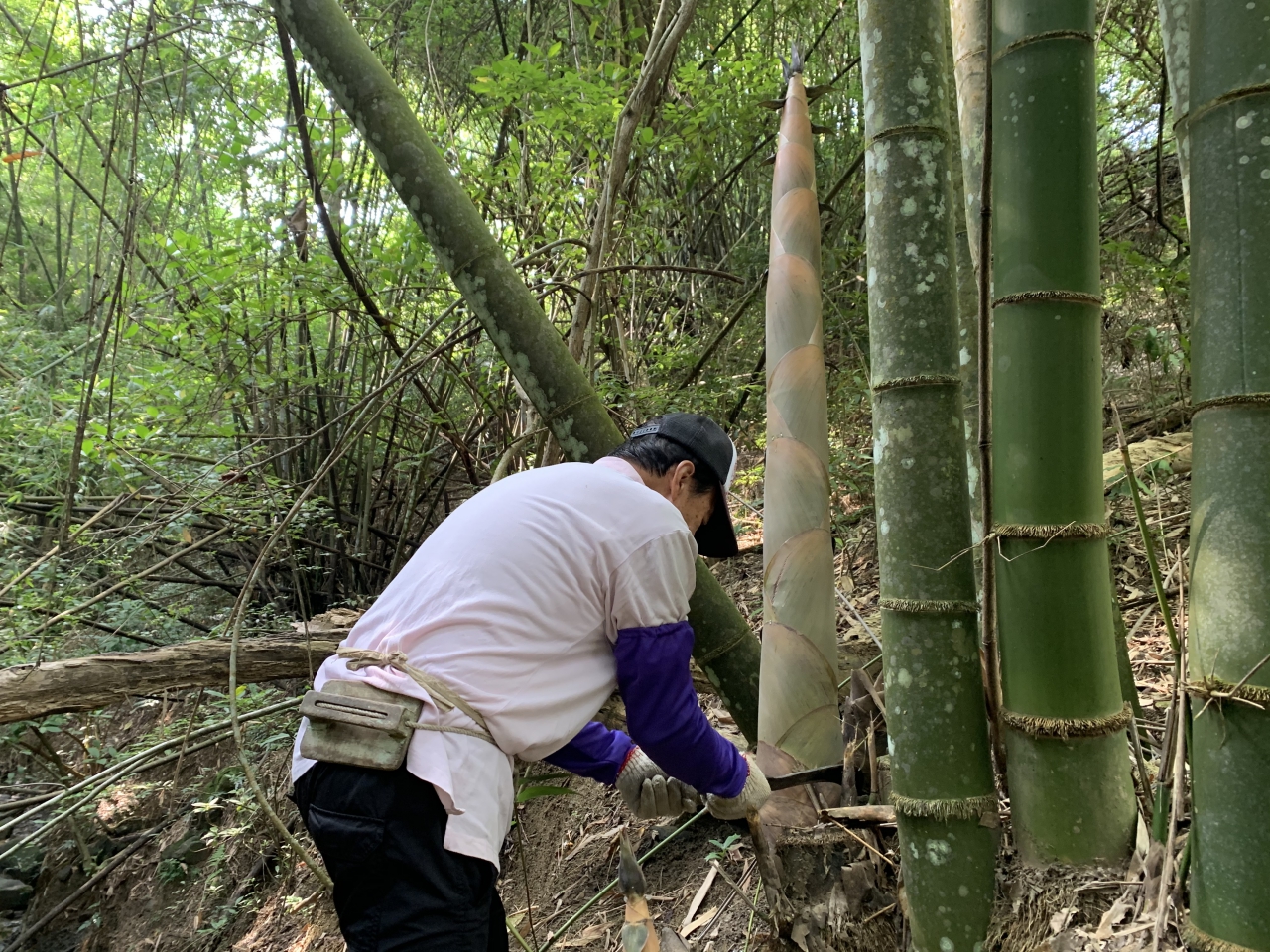正當新類型公共藝術、對話性創作、參與式藝術或是關係美學等立論紛紛提出一些可能性,試著讓藝術離開白盒子,與社會之間開始發生關係並產生互動的當代。我懷抱著近乎信仰並合乎自己個性與體質的創作方法與狀態,著手發起過許多社區型的互動藝術計畫,也感謝這份互動,可以攢點收入讓我能在臺北「直直撞」,或許很早就知道藝術終究不能真的解決任何現實問題,過去,無論進入到都市更新、社子島徵收、街區蕭條還是社會住宅等場域,希望作品能在未來發酵,產生有機會改變各種現況的期待與契機,其實都是一種奢望,創作過程的當下好好陪伴與傾聽已足以,2018年「關渡國際自然藝術季」的展覽「幸福照起工,成為記憶的方法――生活秘境展」中,我們從食物出發,以料理故事為創作的起點,因此當時向社子島的李吳滿阿嬤請益如何做醃冬瓜,阿嬤細心且再三叮嚀地,從選冬瓜、切段、曝曬、裝罐、加米酒跟白豆豉,一個步驟一個步驟的解說製作的「眉角」,過程中,阿嬤不經意地說出「真希望在美國的孫女可以回來一起學」,這番話讓我們感觸良多,我們不禁想著自己的「序大」(文音讀做sī-tuā,長輩的意思),如果這個計畫不是在臺北這個文化場發生,一樣的事情,在家鄉仍然是成立的嗎?
我的阿公出殯火化那天,從甲仙滴水崁一路到仁武的火葬場,沿路上,伴著法師的引磬聲與銅鈴聲,深怕錯過一座橋或是一個山洞與隧道,忘記喊出聲,最後一程,確實地喊出每一聲,聊表一個長孫最後的孝心,按習俗,讓親人尋聲向前,以免害怕橋神,魂魄就沒跟上來。超過90分鐘的路程,「過橋」二個字,喊到懷疑人生,打瞌睡了,還得靠一旁的法師搖醒告知,「怎麼這麼多橋啊!」、「到底到了沒?」、「到底有幾座橋?」這些因為出殯而引發的自忖,催生了走路草農/藝團(簡稱走路草)的作品《湖底田水上考古》,這些橋正是作品中的第一條支線。雖然是以「考現」作為方法,但是因為「湖底田」的關係,串接第二條支線之後,有了考古的感覺。
 走路草農/藝團2018年的作品《湖底田水上考古》。圖/走路草農/藝團提供
走路草農/藝團2018年的作品《湖底田水上考古》。圖/走路草農/藝團提供
「湖底」這個地方,這是大社當地人約定俗成的名稱,與「尖山腳」都在同一個區域,「湖底」與「尖山腳」並非行政地名,地圖上也未曾出現,沒有明確的邊界,只有大概的方向與位置,過去有個私人的湖。如今大雨後,亦時常積水成窪,不易消退,而「湖底田」則是走路草農/藝團成員陳漢聲與家人之間,用來稱呼爺爺留下來田地的名稱,與比鄰在田地旁的大社第三公墓,形成了該系列的第二條支線;我們無意識地把撿骨後,遺留在原墳墓的土地公像,連同石獅一一地安置在田裡,彷彿想要讓「祂們」依然繼續守護似的,有工作與有任務;在不同的形制與樣貌的塑像上,似乎也有著自己的歷史在演變一般。
「湖底田水上考古」其實並非單一件作品,而是一個由不同組件並置而形成的「展覽」;我們騎著機車從大社湖底田出發,前往甲仙滴水崁,一日往返,早出晚歸,一路上數著大大小小、有名無名的橋墩,連同無名橋與重複名稱的編號,在路途中居然有超過一百座橋梁,我們不禁遙想,原來所謂的「翻山越嶺」與「跋山涉水」只是自己「沒看到」而已;就這樣,與作品同名的展場內,散落著這些橋墩的名字、陳漢聲爺爺生前獲贈的匾額,以及公墓撿拾來的土地公像,而原本用來防止偷盜的錄影監視器影像,也成為裝置的一部份,在展場同步即時播放。
該作一開始,或許仍在「農家子弟有自己的歷史嗎?」以及「似乎沒有『文化』的農家子弟有創作的資格嗎?」等問題上打轉,指出自身與原生家庭的關係,亦想碰觸現實中實踐藝術的處境,如今再思考,似乎更想碰觸性別政治與家庭現實的溝通與認同,無論如何,上述中,某些創作狀態、創作方法似乎已漸漸在成形。
 走路草農/藝團於2021年參與C-LAB的「CREATORS創作/研發支持計畫」,以「噥噥時間交換所」所展開的一系列創作計畫,圖中為劉星佑的媽媽在市場進行演出。圖/走路草農/藝團提供
走路草農/藝團於2021年參與C-LAB的「CREATORS創作/研發支持計畫」,以「噥噥時間交換所」所展開的一系列創作計畫,圖中為劉星佑的媽媽在市場進行演出。圖/走路草農/藝團提供
駐地本來就不等於出國,然而現在當「可以駐地」近乎等於「可以出國」一樣,讓人心生羨慕時,不妨讓我們開始想想「不出國而駐地」的可能,又或者「返鄉即駐地」是不是可能的?南貨北賣是經商的門道,而透過駐地而生產的作品,始終難掩島國島民的我們,對於異國情調的嚮往,因為如此,也難怪會有一種說法認為「在國外做什麼都是對的」,然而「故鄉即異鄉」是可能的嗎?
臺灣美術史上,甚至是近代,仍有許多藝術家,因緣際會在接觸到西方思潮之後,開始思考臺灣藝術的主體性,而這樣自我認識的狀態,仍不斷上演著;無論是駐地還是駐村,一直以來,關乎著目光的交換與經驗的交流,最後又回到自我的重新認識以及自我認同;至此,關於「駐地」的想像,還有什麼可能?從駐地這一關鍵字出發,又牽動著各種關於社區營造、地方創生、藝術節等近年在藝文政策下所推動的熱潮,藝術家在這之中如果發現了什麼,可以有什麼實踐縫隙?

把當季川燙後的竹筍,分裝到一個塑膠袋,然後打一個結,這樣的動作需要多久時間?我的父親因為花了20分鐘無法獨立完成,在自責哭泣中說著「我比做藝術還沒用了。」這也讓我生平第一次向前擁抱安慰著自己的父親,「我得回家幫忙」的念頭在腦海中搶灘,關於當代藝術的定義與可能性,當下真的只想說「I don’t fucking care!」,另一個隨即湧上的念頭是「這麼多年過去了,原來藝術對父母而言,仍然是自己一個無用但可以包容的任性。」關於地方創生、返鄉創業甚至在故鄉駐地的可能,真的不需要放棄高薪加以擁抱,只要稍加樂觀正向地、面對父母身體上的衰老與病痛,將更直接地驅使著每個人「返鄉」同時「駐地」的動力;也因為如此,我在2020年末才有機會當個「孝女子」,長時間地與父親單獨相處,並一起執行完採筍的每一個過程。
筍子季大約落在每年的暑假期間,為方便進出山林採筍,端午節後,得穿齊裝備,帶著工具,開著鐵牛車,陸陸續續地沿著山徑「刜筍跤」(phut sún kha),除了除草鋸木,還要移開路上各種可能帶來危險的泥塊石頭。上述過程與其說辛苦,根本是驚險!「開鐵牛車走山路也太危險了吧!路要多窄有多窄!」、「鋤頭也太難用了吧!我永遠無法在同一個痕跡上掘第二下!」、「這蚊子也太多了吧!蚊香根本要用到發爐才有效吧!」各種抱怨中,讓我真正想到哭的是「過去這些年,居然都是由父親一人獨自完成這些工作的!」
 看似單純的採筍工作,事實上有著極為複雜的工序,並仰賴長期的經驗與知識才得以完成,圖為劉星佑的爸爸採筍中。圖/走路草農/藝團提供
看似單純的採筍工作,事實上有著極為複雜的工序,並仰賴長期的經驗與知識才得以完成,圖為劉星佑的爸爸採筍中。圖/走路草農/藝團提供
竹筍採收到工寮便後開始加工,光是用筍刀把筍尾取出的動作,足夠學一整個夏天、浪費一百根竹筍,接下來的切片、浸水、換水、川燙到最後分裝,一樣得按步驟來執行。筍子季大約在白露過後結束,最晚到中秋節便會告一段落,隨後來的便是各種日曬與醃漬食物的加工,從筍乾、高麗菜乾、花菜乾到蘿蔔乾,過程中的各種小知識同樣讓我感到驚奇,除了日曬程度的掌握,風勢與天氣的觀察,就是一個月後在醃筍中加入的「泔」,所謂的「泔」,指的是稀飯煮久後,表面浮起的稠狀物,或是水較多成米湯狀的粥,這個步驟可以隔絕空氣,不讓表面的酸筍氧化變太黑影響美觀與味道的小技巧。走路草成員陳漢聲也一同參與,在採集與加工的過程中,我們不禁在想,究竟藝術的參與可以看到什麼?
長時間待在同一個生活圈,對於生活的感受難免疲乏,新的環境可以帶來新的生活節奏與經驗刺激,而在快速都市化的今日,為了求學或工作而離鄉背井,故鄉隨時間推移變成異鄉是再自然不過的事,即使如此,「我好不熟」的狀態仍不時地會竄出來,之所以會竄出來,不外乎那些在很多知識之外的「常識」在日常生活當中沒有被意識到!
節氣之說對父母而言,那只是天氣允許、當季蔬果便宜,順紲爾爾(sūn-suà niā-niā)的順便之舉罷了,所謂的節氣之說,真的被過度知識化與美學化。「噥噥時間交換所」原本只是一個在臺北創作的自己,想跟進駐場域附近居民互動的計畫,因為2020年發生太多變故,所以覺得沒有邀請自己的父母來擔任「藝術家」的位置,我實在無法宣稱這是我「想」做的作品。
關於「思箱計畫」的緣起與發展過程,在〈一跤(kha)紙箱仔〉一文中,有著詳細的描述,而從一跤(kha)紙箱仔到一個藝術節,則是走路草不滿足於一個作品的生產,或者說,是否能不受公共藝術標案的限制,不受公部門為滿足居民期待的期待所產生的限制,讓藝術節「自然地」發生,回到創作者身上,「把作品導覽當成藝術節內容」的想法應運而生,透過介紹「湖底田水上考古」系列一作、「牆隔神農――陳漢聲個展」、「思箱計畫」等創作,我們有機會自己旁觀自己,並著手安排藝術節的內容。此時的我們,非常感謝藝術節的氾濫,好讓藝術節在變成一種較為通俗、日常甚至是有刻板印象的用語,非常便於對外溝通與協調,當我們在協調過程中,聽到合作單位表示「我們大社也要有藝術節了喔!」或是「這裡也可以看到藝術喔?」的時候,走路草就更確定這一切是有機會發生的。
連當地人都不曾走訪的湖底田與公墓,因為作品的關係,讓參與者可以現地的感受到,藝術家如何思考著眼前這塊土地,而位在工業區旁的「仁大工業區三中路綠化牆紀念碑」是連當地人駕駛途經都僅僅呼嘯而過,不曾注意到的地方,透過這塊紀念碑上文字的拓印與閱讀,大社工業區原定於2018年由特種工業區降為乙種工業區的議題,便自然地在作品中被闡述,更重要的是參與者在此直接看到眼前一大片的工廠,並聞到刺鼻的塑膠味。
 2019年的大社在這裡「農閒藝術節」,是走路草農/藝團舉辦的首屆大社在地藝術節。圖/走路草農/藝團提供
2019年的大社在這裡「農閒藝術節」,是走路草農/藝團舉辦的首屆大社在地藝術節。圖/走路草農/藝團提供
故鄉與異鄉或許沒有地點上的差異,只有隨著置身在不同的地方,立場與觀點尺度的變化,也唯有如此,才能在既有的經驗中,折射出新的事物,並找出新的方法論;在「湖底田水上考古」系列中,我與陳漢聲成為彼此駐地觀察的對象,進而交織出這系列的作品,在我們發起的「農閒藝術節」裡,無論是把計畫當成一件作品,還是在把一件作品做成計畫,藝術家的態度依然不變,而是對於現實社會身分的不再固著,並開始產生流動;無論要在創作計畫裡成為一名藝術行政?策展人?甚至僅僅是一名觀眾?在「噥噥時間交換所」的計畫裡,意外地讓返鄉成為駐地,讓父母於臺北駐地,暫時地成為一名餐飲講師,講解食物的醃漬方法與烹飪方式,或是成為一名DJ,在八德市場分享自己國高中時期購買的黑膠唱片,或是直接成為一名「有用的」藝術家,或是回到為人父母的角色,傾聽自己孩子以外,藝文相關工作者的職場甘苦談。
「你媽知道你在這裡鬼混嗎?」是就讀藝術大學時,同學之間因熬做作品,用來調侃彼此的話語。在藝術知識化的今日,藝術或許不會因為讓他人理解了,就被認為不是在鬼混,但是,比被理解還重要的,是邀請他人參與,並讓他人成為創作者與生產者,此時的「鬼混」才顯得特別有機,像上山採筍子一樣,偶爾可以遇到木耳、竹笙、雨來菇、雞肉絲菇等意外的收獲。